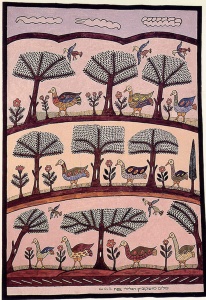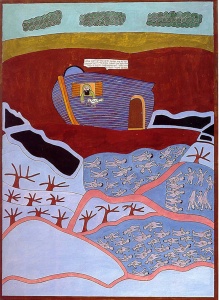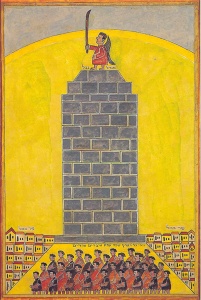Paintings of Shalom of Safed
There once lived a pious old man in Safed. His great-grandparents had come from Eastern Europe to Eretz Yisroel sometime in the eighteenth century. He remembered back when the Turks ruled Palestine and then the English came and tried to govern this difficult land. In those years Safed was a mix of Arab and Jew, Sephardi and Ashkenazi. Shalom Moskovitz was a watchmaker by trade but also worked as a scribe, a silversmith and even a stonemason. He did whatever it took to put food on his humble table and feed his family. Then it happened that his workshop was destroyed in the riots during the War for Independence in 1948. All the tools of his trade were lost. What might he do? He turned from the life of a practical craftsman to the life of an artist, first making folk-art toys and then simple paintings. He became, when he was just entering his seventies, perhaps one of the most original Israeli artists of the twentieth century. He was Shalom of Safed.
Shalom of Safed (1887-1980) was a primitive artist who created in the last thirty years of his life a large opus of paintings devoted to the Torah and Jewish life. Collector and patron Daniel Doron believed that “Shalom’s art represents… a unique blend between a literary tradition–the Hasidic heritage and the mystical lore of the Cabala–and the artist’s sensitivity to the light and landscape of the Galilee.” As a pious Jew in the sleepy insular environment of Safed he had no knowledge of art history or contemporary art, nevertheless his work has a surprisingly modernist flavor. It tends to be flat with broad areas of strong, evocative color. Figurative elements are subsumed within a powerful graphic composition. Textual passages are incorporated into the image echoing some Pop Art masterpieces and prefiguring many Post-modern techniques. These modernist elements are typical manifestations of many aspects of ‘naive’ folk art. The difference here is that Shalom utilizes these techniques in an extremely focused depiction of the Biblical narrative where the modernism of his form actively reflects and enhances the Torah meaning.
It is easy to begin at the beginning with Shalom since he seems to have done a painting, sometimes more than one, on most passages in the Torah. Following line by line the account of creation Shalom envisions the Separation of Light and Darkness, and the Creation of Lights in images divided into many different registers (sectioned bands of images one on top of the other). First there is only the intense blue of the waters above and the waters below that sandwich a molten orange sun trapped in primeval magna. Bands of pitch-black darkness are embedded within the incoherent totality of creation. In another painting the sun, moon and stars appear suspended over a topsy-turvy landscape.

The Birds of Paradise (1965) march across three registers of tree lined landscapes in yet another delightful image. The invented multi-colored birds are all walking right to left, each approaching a childish flower under a stylized tree. The repeated rhythms of bird/flower/tree creates a peaceful harmony in soft counterpoint to the subtle differences of color and detail as we move up from register to register.
Noah’s Ark provides a fertile occasion for depicting many diverse animals marching two by two all from right to left yet again. The register on top shows Noah picking figs and his entire family preparing for the voyage in the ark. In the bottom register they are seen entering the Ark with Shem and his wife entering by a separate door, perhaps reflecting the honor of their descendants, the Jewish people. In the lowest register of the animals one notices that the very last, the elephant, has no partner. When questioned about this Shalom replied; “Noah would have a space problem so he took only one elephant–a pregnant one.” This creative combination of artistic wit and midrashic freedom characterizes much of Shalom’s work.

The Great Flood was of course the world’s first great tragedy, a watery holocaust for all mankind. The Dove Returns to Noah’s Ark (1963) addresses exactly this conundrum. The bottom sections of the painting are fields of blue gray devastation, barren trees, pits of black emptiness and corpses floating in shallow pools. The ark is encased in a field of brown mud while Noah grasps the dove that has returned with the olive leaf. The text above Noah tells us that “…Noah knew that the waters had subsided from upon the earth.” As Noah gazes out on this terrible landscape he also knows the consequences of the Flood, the bodies that litter the bottom of the painting. Pointedly Shalom depicts them all with Hitler-like moustaches and dark hair parted on the side. The world had become filled with corruption “for all flesh had corrupted its way upon the earth” and still one is moved by the gravity and color of the painting knowing that God’s retribution was terrible indeed. He does not rejoice in the annihilation of the wicked.
Shalom does not simply accept the text at face value. Instead he visualizes it in a wide, inclusive view, providing narrative context and midrashic elements that immediately shapes the meaning, exposing elements that we have long glossed over or never noticed.

The Tower of Babel (1963) opens up the text “And the whole world was of one language and of one speech” (Genesis 11:1) to the midrash that explains that “ R. Leazar said:.. of veiled deeds, for the deeds of the generation of the Flood are explicitly stated, whereas those of the generation of Separation are not explicitly stated.” Shalom creates a massive tower of finely hewn masonry (remember he was once a mason) situated above the determined populace of contemporary figures in the City of Babel below. Atop the tower a winged figure menaces the sky above with an enormous sword to fulfill yet another midrash that tells us that their rebellion went so far as to attempt to supplant God from His Heavenly abode. They said, “Come, rather, and let us build a tower at the top of which we will set an idol holding a sword, that it may appear to wage war with Him” (Midrash Rabba 38:6). Shalom’s bright yellow background against the cool grays of the tower and upper sky casts a brilliant light on one of mankind’s frequent rebellions against their Creator.
Shalom of Safed expanded the world of Torah with his many images. He maintained he did not transgress the Second Commandment since he “did not make paintings, but retold the story of the Bible in color and in line.” Surely he never sinned in making forbidden images, but just as surely he did much more than simply retell a story. In his masterful use of text, color, line, form, texture and composition he adds meaning, elicits questions and reinvigorates our understanding. His creativity, not limited to the artist’s tools, is in picturing diverse elements of narrative, bringing them together so that we must see each parsha anew. He has reportedly said, “I am a serious man. I do not paint out my imagination.” Certainly not. Rather he paints out of his beloved Torah.
(Quotations, images and background information are from Images from the Bible: The Paintings of Shalom of Safed: The Words of Elie Wiesel with an introduction by Daniel Doron, The Overlook Press, Woodstock, N.Y. 1980)